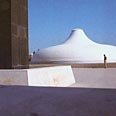
Most of Israel Museum closes for renovations
Eighty percent of the Israel Museum’s exhibition space is to undergo renovation, with the work to be completed in two-and-a-half years. Most exhibits will be closed to the public, with some transferred to museums abroad and others displayed as changing exhibits
At a press conference held at the museum earlier this week with Dor Lin, deputy director for planning & development and Zvi Efrat of Efrat-Kowalsky Architects, it was announced that most of the burden will be placed on the Youth Wing, Bet Ticho, and the Rockefeller Museum, which will host the art objects that are to become homeless. Among the collections to be displaced are the ethnographic collection, the Impressionist and modern art collections, the African and Far Eastern art collections, Judaica, and Archeology of the Land of Israel.
An $80 million story
The project will cost some $80 million. The museum has received $10 million from the government, and the rest from 16 private donors. This is the most comprehensive project undertaken at the museum since 1965, and is intended to provide better access to the main exhibition spaces while remaining faithful to the design of Alfred Mansfeld.
The museum has grown ten-fold since it was built, and a model of Jerusalem in the Second Temple period has recently been added. The multi-year plan includes creation of a new entrance, building of a roofed passage from the main entrance to the new entrance hall, reorganization and expansion of the permanent exhibitions, and the building of a new space for changing exhibits. Some 8,000 meters will be added to the building, and 20,000 meters of exhibition halls will be renovated, expanded, and redesigned.
How will such an extensive project be carried out while the museum is open to visitors? The answer given was that “a great deal of thought has been invested in planning and implementation.”
Museum director James Snyder stated that “the open space of the campus will be exploited in a new way, and all means will be taken to present the collections in the most effective way, including lending collections to museums abroad. At the moment there is an exhibit about the cradle of Christianity being shown in Atlanta, and we intend to move additional exhibits abroad.”
And if there were more money, would you do things differently?
“No. First we developed a plan, we calculated the cost and obtained all the funding. People in Israel do not understand that this is not a matter of money.”
But won’t the intermediate solution harm the museum?
“Most people in any case use the portions that will remain open. What museums abroad have done (sending all the exhibits to another museum, for example) is a strategy of one kind, and we had a different strategy.”
“If I built a large tent and housed all the exhibits in it, or spread them around museums throughout the city, researchers would have to run around, and what we are doing now is that during the renovations we are employing the researchers in re-cataloguing all the items in the museum, and allowing them wider access. Our purpose is to give a resource to the researchers and to maintain the active content. The scandal is not the renovation of the museum. The scandal is that people do not use the museum enough.”
But even if we wanted to use it we couldn't see all the permanent exhibits in the next two-and-a-half years.
“There are over five thousand items in the museum. You can never see them all.”
Museum sources claim that museum members have received a number of notices of the renovations over the course of the year, and promised that they would receive full value for their membership. They also claimed that once the renovation plan was developed, anyone purchasing a membership was notified of the plan.
According to the Jerusalem municipality spokesman’s office, “The Israel Museum is an important layer in both the city’s cultural scene and tourist scene. The museum is not being closed, but upgraded. The renovations, which will continue for about three years, will turn it into the leading institution of its kind in the country, disabled-accessible, modern, and suited to the capital of Israel.
"According to what we have been told, the museum will continue to function, and to hold, even during the renovations, many events and activities in which visitors will be invited to take part. The museum staff, which is the leader in Israel and one of the leaders in the world, will have to invest its best efforts and means, and this is what we are doing.”















